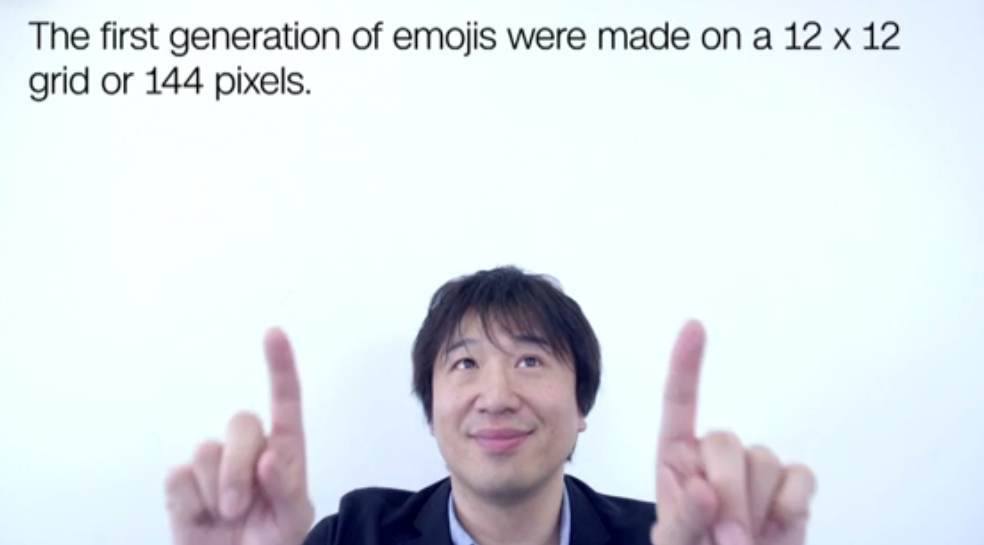
Emojis have become, without doubt, a design classic. But how effective are they as a communication tool? Over 6 billion emojis are sent on a daily basis, with over 90% of the world's online community making regular use of them. Emojis may be one of Japan's greatest-ever exports. Today they are even officially classified as art. In 2016, New York's Museum of Modern Art added emojis to its permanent collection— more specifically, the original 176 emojis, designed by Tokyo-based software engineer Shigetaka Kurita in 1999.
In the late 1990s, Kurita—working for NTT DoCoMo, one of the largest Japanese mobile telephone operators—was involved in the development of the world's first commercial, mobile-specific internet browser system. Given display limitations in early Japanese smart phone screens, Kurita decided to develop pictograms to make displaying information more effective. Taking their name from the Japanese word for "picture character" , emojis were born.
What makes English, Japanese, or Chinese a language is the presence of two things: words and rules. And it is the unique nature of this organization that allows us to express ideas that cannot be expressed using other systems of communication. Language is organized into meaningful units such as words, and a system of rules—a grammar —that enables us to express everything from the love to the observation on the weather.
Compared to, say, English, emoji has a far, far smaller “vocabulary” .While new emojis are introduced each year, the number of emojis available is small compared to the range and complexity of vocabulary items that a competent native speaker possesses — currently there are fewer than 2,000 emojis available on a smart phone near you. But adding more and more emojis will only get us so far. A problem is the difficulty of expressing abstract ideas using a pictographic form. Winks, smileys, eggplants and dumplings are one thing — but how might we go about representing, say, "quality" "value" or "enthusiastic" in emoji?
本时文内容由奇速英语国际教育研究院原创编写,未经书面授权,禁止复制和任何商业用途,版权所有,侵权必究!(投稿及合作联系:028-84400718 QQ:757722345)
1.Why are emojis one of Japan's greatest-ever exports?
A Emojis have become a design classic now.
B Emojis are widely used all over the world.
C Emojis are not effective as the languages.
D Emojis are generally considered as art.
解析:选B。细节理解题。根据文章第一段第三句的Over 6 billion emojis are sent on a daily basis, with over 90% of the world's online community making regular use of them.可以得知表情符号在全世界被使用,因此可以说是日本出口最多的东西。故选B。
2.Why did Kurita invent the emojis?
A Because he wanted to make internet browser system faster.
B Because he wanted to display information more effectively.
C Because he wanted to make the smart phones easier to use.
D Because he wanted to be a Tokyo-based software engineer.
解析:选B。推理判断题。根据第二段第二句的Given display limitations in early Japanese smart phone screens, Kurita decided to develop pictograms to make displaying information more effective.可以得知,设计者想要让智能手机呈现信息更加有效。故选B。
3.How can people organize language into meaningful units?
A People use the picture character.
B People can observe the weather.
C People make use of the signals.
D People use the system of rules.
解析:选D。细节理解题。根据第三段最后一句的Language is organized into meaningful units such as words, and a system of rules— a grammar可以得知是语言规则,也就是语法才让人们把语言组织成有意义的语段的。故选D。
4.What is the disadvantage of the emojis in communication?
A It doesn’t have the great numbers.
B It can’t express the abstract ideas.
C It can’t stand for words and rules.
D It has unique nature of organization.
解析:选B。细节理解题。根据文章最后一段中的A problem is the difficulty of expressing abstract ideas using a pictographic form. 可以得知使用表情符号没法表达抽象概念的信息。故选B。